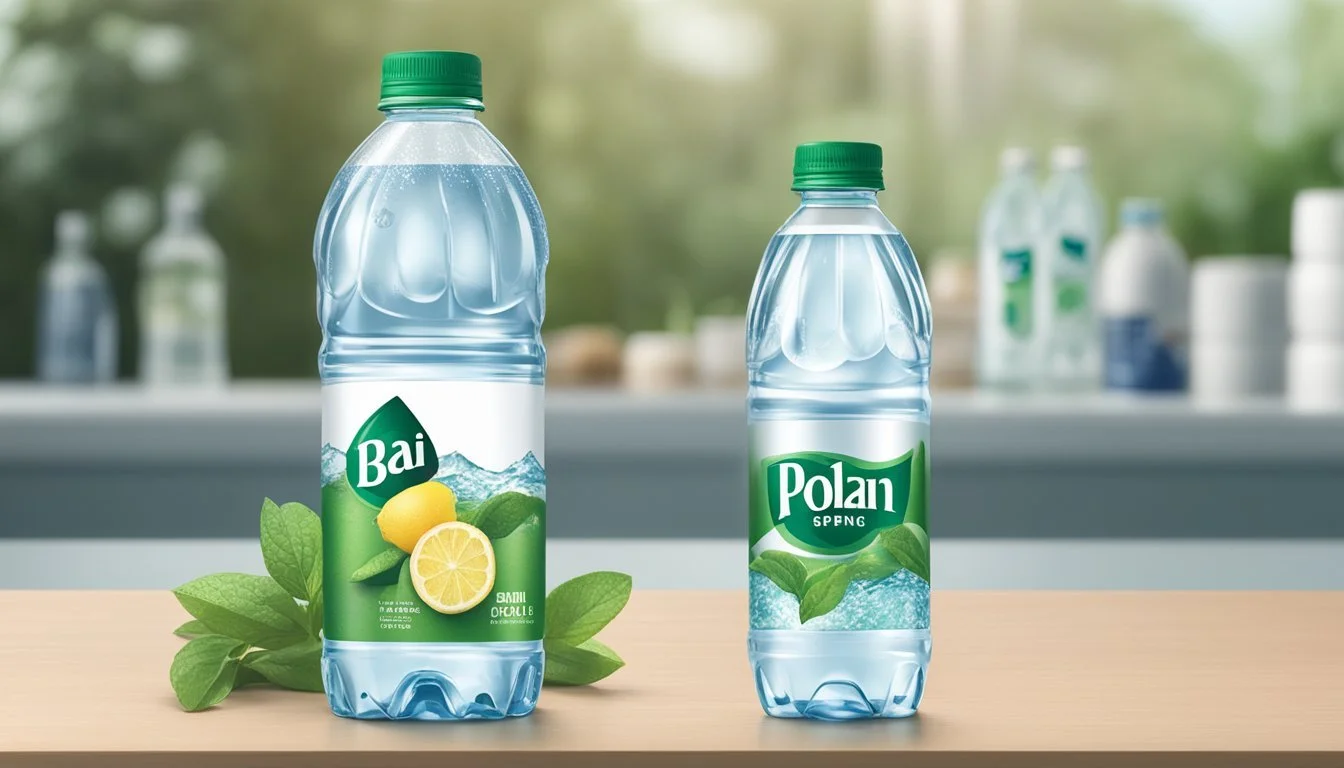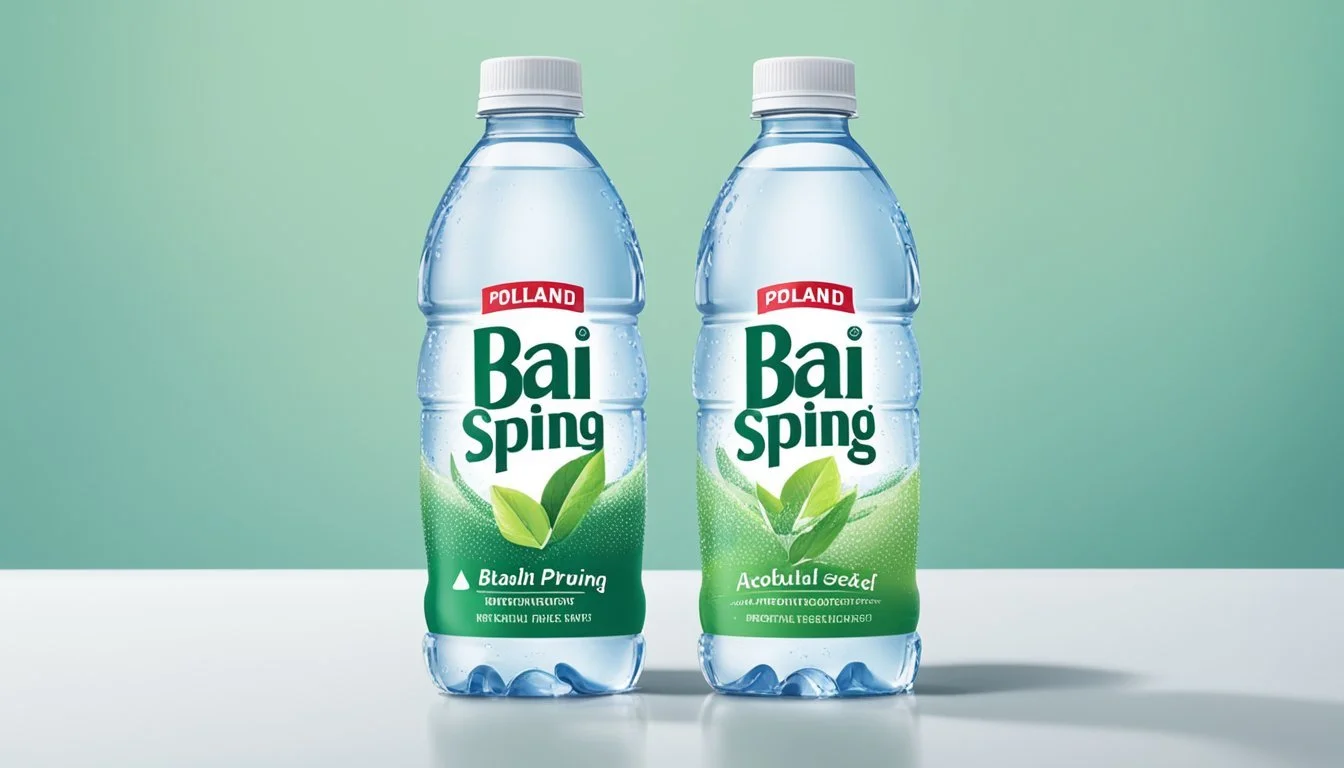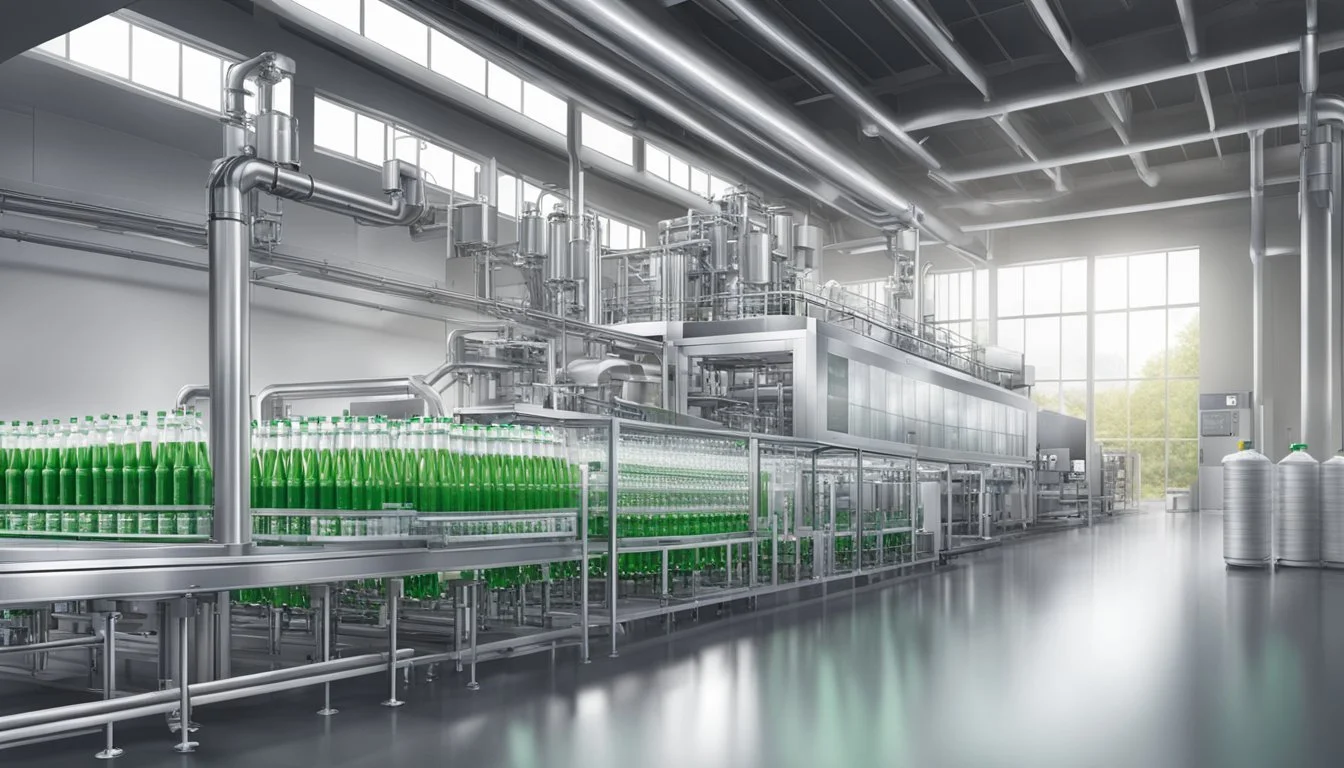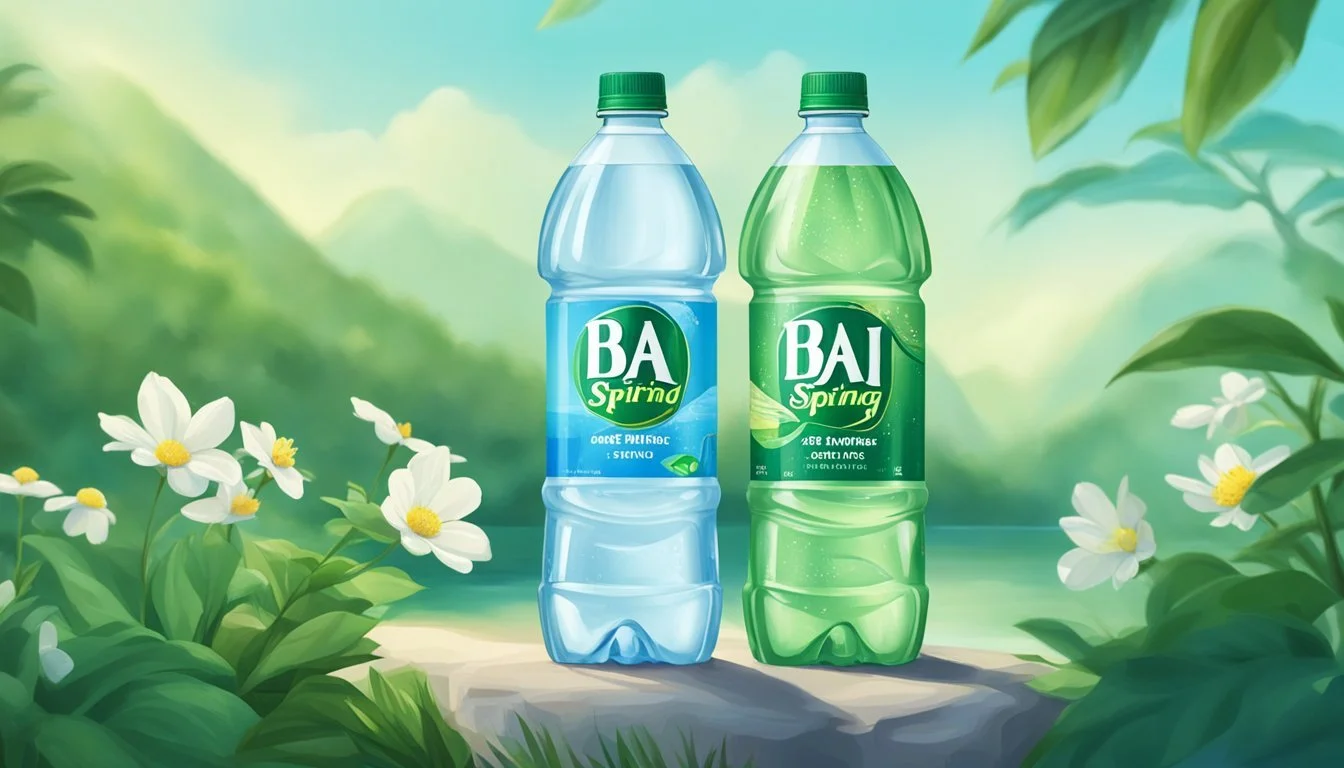Bai vs. Poland Spring
A Comprehensive Comparison of Bottled Water Brands
Choosing the right bottled water can be a more complex decision than it might seem at first glance. With an increasing number of brands offering various purported benefits and sourcing stories, consumers are often left weighing factors such as taste, purity, and the source of the water. Bai and Poland Spring represent two distinct options in the marketplace. Bai, known for its antioxidant-infused beverages, offers a flavored water experience, while Poland Spring, a long-standing brand, purports to offer 100% natural spring water from Maine.
The debate over which bottled water is better depends on individual preferences and priorities. Poland Spring's reputation has been built on being a straightforward, natural water choice with a long history, whereas Bai's approach is more modern, infusing water with flavors and antioxidants. Furthermore, in the context of environmental impact and health concerns, consumers may be influenced by the sustainability of the packaging and the presence of additives in the water they choose.
These considerations highlight the complexity behind a seemingly simple choice. The comparison between Bai and Poland Spring unveils a deeper dialogue about what consumers value in the bottled water they drink – be it the additive-free, natural sourcing that Poland Spring claims or the enhanced taste and potential health benefits that Bai offers. This article seeks to explore these factors to help readers make an informed decision between the two brands.
Assessment of Sources
When examining bottled water brands like Bai and Poland Spring, the quality and origin of their sources are paramount. This section delves into the sourcing practices of these brands to understand what sets them apart.
Source Evaluation: Bai and Poland Spring
Bai water sources are less publicized, but the company highlights the use of filtered municipal water, enhanced with antioxidants. Poland Spring claims to use natural spring water, primarily sourced from several springs in Maine, including the notable Garden Spring. Poland Spring's water is filtered naturally through glacial sands, which attributes to its taste and quality.
Spring Water vs. Other Types
Not all bottled waters are created equally. Spring water must come from an underground formation from which water flows naturally to the surface. Poland Spring’s labels indicate that their water is collected from such springs. In contrast, some brands may use purified water, which starting from any source, including municipal water, has been processed to remove all minerals and contaminants. Bai's brand falls under this category, offering water that often originates from municipal sources and undergoes purification.
Water Type Source Processing Needed Spring Water Natural Springs, Groundwater Minimal, Natural Filtration Purified Water Municipal Water or Others Extensive, Artificial Filtration
Local Sources and Sustainability
Local sourcing can offer sustainability benefits by reducing the transportation footprint. Poland Spring water is sourced from within Maine, suggesting a lower transportation impact for local consumers. The use of local springs for Poland Spring products, such as Garden Spring, also emphasizes the brand's commitment to regional sourcing. However, it is essential to note that transporting heavy bottles of water over long distances can diminish these advantages. Conversely, Bai's commitment to sustainability is not clearly outlined in context with local sourcing, but its focus is on providing a product enhanced with additional health benefits rather than the source's locality.
In summary, Poland Spring's utilization of natural spring water from Maine and Bai's use of enhanced municipal water showcase two different approaches to bottled water. Each has its value proposition and appeals to different consumer preferences, focusing either on the natural quality of the source or added enhancements.
Brand Profiles
This section provides a focused look at the histories and market presences of Bai and Poland Spring. It details the origins, ownership, and notable aspects of each brand.
Bai Brand Overview
Bai Brands was founded in Princeton, New Jersey, in 2009 with the goal of delivering innovative beverage products. The company emphasizes the use of the coffee fruit for its antioxidant properties. Coca-Cola acquired Bai Brands in 2017, expanding its portfolio in the health-conscious consumer market. Bai offers a range of antioxidant-infused beverages, though it is not traditionally recognized for bottled water products.
Poland Spring Brand History
Poland Spring has its roots stretching back to 1845 in Maine, providing a long history in the bottled water industry. Owned by Nestlé, a major player in the global food and beverage sector, Poland Spring is well-known for its spring water sourced from multiple springs in Maine. The brand has built a reputation for natural and pure water, often being associated with high quality and reliability in the bottled water market.
Health and Hydration
When comparing bottled water brands like Bai and Poland Spring, it's important to consider their contributions to hydration and the minerals they provide, which can play a crucial role in overall health and wellness.
Mineral Content and Health Benefits
Bai and Poland Spring waters offer different profiles when it comes to mineral content. Poland Spring, sourced from multiple springs in Maine, typically contains naturally occurring minerals such as calcium, magnesium, and potassium. These minerals are essential for bone health, cardiovascular function, and managing blood pressure.
Bai water, on the other hand, is known for being infused with antioxidants and may contain added minerals, making it a hydrating choice with potential additional benefits. However, one should always review the label for specifics on mineral content, as added minerals may vary between different Bai products.
Hydration and Electrolyte Balance
Hydration is critical for bodily functions, and effective hydration depends largely on the presence of electrolytes like sodium, potassium, magnesium, and calcium.
Poland Spring water, with its natural electrolytes, can help maintain electrolyte balance, which is vital for muscle function and nerve transmission. The presence of minerals like calcium and magnesium can assist in replenishing the body's needs, especially after physical exertion.
Bai waters often come with added electrolytes, which can be beneficial for quickly restoring hydration balance. In addition to its antioxidant properties, Bai may incorporate electrolytes like potassium and sodium in its enhanced water products, potentially supporting hydration after workouts or periods of high fluid loss.
Neither Bai nor Poland Spring typically includes fluoride, a mineral often added to public water supplies to promote dental health but can be a point of personal preference for consumers when selecting bottled water.
Taste and Purity
When debating between Bai and Poland Spring bottled waters, one must consider the distinct flavor profiles each brand offers and the rigorous purity standards they uphold, including the presence of contaminants and the pH level.
Flavor Profiles
Bai water is known for its flavor-infused varieties, offering a broader range of choices aside from plain water. These include fruit-inspired options that add a subtle taste without overwhelming sweetness. On the other hand, Poland Spring boasts a natural flavor described as crisp and fresh, resulting from its source in Maine's springs. Unlike Bai’s infused waters, Poland Spring remains within the bounds of traditional water taste, offering a smooth finish that many consumers associate with natural spring water.
Purity Standards and Contaminants
The purity of bottled water is crucial and heavily regulated. Both Bai and Poland Spring adhere to FDA regulations. Poland Spring asserts that its water, sourced from springs, meets stringent state and federal standards. The brand's filtering process is aimed at maintaining the natural purity of the spring water, ensuring it is free from lead, chlorine, and other contaminants.
Bottled water brands such as Dasani, Aquafina, and Evian have set precedence in the industry for pure water. Evian, sourced from the French Alps, and Fiji Water, which journeys through volcanic rocks, along with Voss, are often noted for their high purity levels. Brands like CORE Hydration, Essentia, and smartwater also emphasize their filtration and enhancement processes, whether it be through reverse osmosis or added electrolytes to achieve a higher pH level, often marketed as alkaline water.
In summary, Bai offers a variety of flavored waters that cater to those looking for an alternative to plain water, while Poland Spring upholds the traditional water taste profile with the promise of natural spring water purity. In this context, water's pH level, along with absence of lead, chlorine, and other possible contaminants, come into focus, making the water's purity and crisp, fresh taste the linchpins of bottled water quality.
Comparative Analysis
In this section, the attributes of Bai and Poland Spring bottled waters are examined, distilling their quality and environmental considerations to understand which product stands out.
Comparison by Quality
Bai bottled water promotes itself as a premium beverage option, known for its flavored waters which contain antioxidants and are infused with flavors from exotic fruits. Bai waters typically undergo processes such as reverse osmosis and are enhanced with electrolytes for taste. While their fruit-flavored waters are not necessarily pure water, the brand's emphasis is on a balance between hydration and taste.
On the other side, Poland Spring is a brand that markets itself under the premise of natural spring water. Analysis from search results suggests that Poland Spring's taste is generally pleasant, a factor attributed to its natural mineral content. However, concerns have arisen over the authenticity of its source, with Poland Spring defending its classification as 100% natural spring water.
Reverse Osmosis: Utilized by Bai to purify water, effectively removing heavy metals and contaminants.
Natural Sources: Poland Spring claims water sourced from springs in Maine, emphasizing natural filtration.
Criteria Bai Poland Spring Source Regional municipal waters (enhanced) Springs in Maine (natural) Filtration Process Reverse Osmosis, Ultraviolet Light, Ozone Natural Filtration, possibly some artificial steps Flavor Infused with exotic fruits and antioxidants Natural mineral taste Purity High, due to reverse osmosis Questioned due to source controversy
Environmental Impact and Ethics
When discussing the environmental impact and ethics of bottled waters, it is important to analyze the sustainability practices each company employs as well as the impact of the packaging.
Bai offers products that are innovative and geared towards health-conscious consumers, but the environmental impact hinges on their use of plastic bottles, which are recyclable. The brand's focus on 'better-for-you' ingredients suggests a level of care for the consumers' well-being, but does not directly translate to environmental concerns.
Poland Spring, under the umbrella of Nestlé Waters, has encountered critique for its environmental practices. They have made commitments to increase the amount of recycled plastic in their bottles and promote sustainable resource management. However, this should be weighed against the brand's past controversies regarding water sourcing and implications of draining local water supplies.
Packaging: Both utilize plastic bottles, which pose environmental concerns despite being recyclable.
Corporate Ethics: Bai's health-oriented approach does not necessarily address environmental ethics, whereas Poland Spring has made ethical pledges amidst criticism.
It's integral to evaluate both the product's quality and the environmental impact to make an informed decision between Bai and Poland Spring bottled waters.
Consumer Considerations
When consumers choose between Bai and Poland Spring bottled water, they weigh factors like market prevalence and cost against the perceived quality and benefits of the product. Each brand's ability to meet these consumer expectations can directly influence its success.
Market Demand and Availability
Bai and Poland Spring have carved out distinct niches in the bottled water market, but their availability varies. Poland Spring, being one of the most recognized water brands in the United States, especially in the Northeast, ensures consumers have easy access to its products both in stores and through online retailers. Bai, known for infusing their waters with antioxidant-rich elements, may not have the same level of ubiquity as Poland Spring, but it has been growing its presence on the market and appeals to health-conscious consumers seeking added benefits from their beverages.
Brand Availability in Stores Online Purchase Options Bai Selective Retailers Widely available Poland Spring Extensive Retailers Widely available
Pricing and Value
The cost of Bai and Poland Spring water can influence a consumer's choice significantly. Poland Spring typically provides a cost-effective option for consumers looking for pure spring water without additional enhancements. Bai, on the other hand, positions itself as a premium product with prices reflecting the added value of antioxidants and flavors it provides.
Poland Spring:
Pros: Cost-effective, widely trusted
Cons: Less differentiation in product offerings
Bai:
Pros: Enhanced with antioxidants, unique flavor profiles
Cons: Priced higher than typical bottled waters
Consumers often assess the value based on whether the added benefits of Bai's product line justify its higher cost relative to the straightforward offering of Poland Spring. Companies like Poland Spring and Bai are in constant competition to balance consumer demand for convenience, quality, and value.
Regulatory Standards and Certifications
When selecting bottled water, regulatory standards and certifications provide consumers with assurance about the safety and quality of the product they are consuming.
EPA and FDA Regulations
Bottled water, such as Bai and Poland Spring, is regulated by the U.S. Food and Drug Administration (FDA), ensuring that it meets stringent safety and quality standards. These standards are often comparable to the U.S. Environmental Protection Agency (EPA) regulations, which oversee tap water. The FDA's regulations include limits on contaminants and requires regular testing. Companies like Bai and Poland Spring must comply with the FDA's standards to ensure their bottled water is safe for consumption.
Contaminant Levels: The FDA mandates specific limits on contaminants, including chemical, physical, microbial, and radiological elements.
Inspection and Testing: Manufacturers are required to conduct regular testing of their water sources and finished products to ensure compliance.
Certifications and Quality Seals
Certifications and quality seals from third-party organizations can further substantiate the purity and quality of bottled water brands. These seals are indications that the water has been subjected to additional testing and meets certain criteria that may go beyond government regulations.
NSF International: A public health and safety organization that certifies products meet public health and safety standards.
IBWA: The International Bottled Water Association offers a voluntary certification program, ensuring additional safety measures and quality checks.
Companies may display these seals on their labels, allowing consumers to make informed choices based on the presence of certified quality endorsements. Bai and Poland Spring, if certified, would include such seals to communicate compliance with these higher standards.
Environmental Concerns and Sustainability
When comparing Bai and Poland Spring bottled waters, the discussion often turns to the products' environmental impact and sustainability. Both brands contribute differently to these concerns, and they are vital when assessing bottled water choices from an environmental standpoint.
Bottled Water and Eco-Friendliness
Bai offers antioxidant-infused beverages that typically come in PET plastic bottles. PET is recyclable, and Bai emphasizes their use of bottles that contain recycled material. However, the environmental footprint still includes the issues related to single-use plastics, such as energy consumption in production and challenges in recycling efficiency.
Recyclability: PET bottles from Bai are 100% recyclable.
Recycled Content: Bai's bottles include a certain percentage of recycled material.
Poland Spring, a water brand owned by BlueTriton, previously known as Nestlé Waters North America, has faced criticism for its environmental claims. Reports indicate that Poland Spring's sustainability pronouncements may have been overstated or described as "vague and hyperbolic". Poland Spring uses plastic bottles as well, and while there is a promise of moving towards more eco-friendly practices, concerns arise around the actual implementation and impact on the environment.
Advertising Claims: Claims by Poland Spring regarding sustainability have been challenged.
Packaging: Plastic packaging remains an environmental concern.
Source Protection and Conservation
Bai does not directly source natural water, but rather uses filtered municipal water. Their impact on natural water sources may be minimal; however, the energy used in filtration and bottling processes is a factor in environmental sustainability.
Water Sourcing: Filtered municipal water with minimal impact on natural sources.
Energy Usage: The filtration and bottling process consumes energy.
Poland Spring has historically attributed its water to natural springs in Maine, which has raised concerns about source depletion and local ecosystem impact. Proper management and conservation of water sources are crucial to maintaining environmental balance and sustainability. Poland Spring has claimed efforts to protect and sustain natural water sources, but scrutiny remains on their actual practices and potential effects on aquifers.
Source Depletion: Concerns have been raised regarding the depletion of natural springs.
Ecosystem Impact: The extraction process might affect local ecosystems.
Innovation and Technology in Bottling
In the bottled water industry, innovation and technology play pivotal roles in ensuring the purity and quality of the water we drink. Advanced filtration systems and cutting-edge bottling processes are crucial to distinguish brands like Bai and Poland Spring.
Filtration Processes
One of the most significant technological advancements in water filtration is reverse osmosis. This process involves forcing water through a semi-permeable membrane, effectively removing contaminants to produce clean drinking water. Additionally, proprietary filtration technologies such as Hydro-7™, a multi-step filtration process used by some brands, further refine water by removing impurities and ensuring a consistent taste profile.
Reverse Osmosis:
Purpose: Removes a wide range of contaminants including particles, dissolved solids, and some pathogens.
Process: Water is pushed through a semi-permeable membrane under pressure.
Proprietary Filtration Technologies (e.g., Hydro-7™):
Purpose: Tailored to remove specific impurities and maintain a unique taste.
Process: Typically involves multiple stages of filtration, each targeting different impurities.
Bottling Innovations
When it comes to bottling, Poland Spring is exploring eco-friendly packaging made from wood materials. This initiative not only seeks to reduce the brand's environmental footprint but also resonates with consumers who value sustainability. Such bottling innovations encapsulate both the responsiveness to ecological concerns and the pursuit of technological advances in the bottled water industry.
Sustainable Materials:
Innovation: Packaging from renewable resources like wood from local trees.
Goal: To provide a more environmentally responsible alternative to traditional plastics.
Efficiency in Production:
Advancements: Use of energy-efficient bottling lines and waste-reduction techniques.
Outcome: Reduction in the overall carbon footprint of the manufacturing process.
By integrating cutting-edge filtration methodologies and embracing sustainable bottling practices, brands like Bai and Poland Spring demonstrate their commitment to quality and environmental stewardship within the competitive bottled water market.
Alternative Water Options
When considering Bai and Poland Spring, consumers also have a variety of alternative water options that may align more closely with their tastes or values. Exploring these options includes a comparison with tap water and an examination of other bottled water brands.
Tap Water Comparison
Tap water is a readily available and cost-effective alternative to bottled water brands. Many municipalities treat their water supply extensively, making it safe for consumption. For example, tap water in some cities may contain comparable levels of dissolved solids to certain bottled water options like Poland Spring. However, the taste and mineral content can vary significantly based on geographic location and the source of water.
Other Bottled Water Brands
Consumers also have the option to explore a variety of other bottled water brands. Each brand sources its water differently, which can affect taste and mineral content. Here are a few notable brands:
Mountain Valley Spring Water: Sourced from a natural spring in the Ouachita Mountains, it is known for its purity and mineral content.
Deer Park: Offers natural spring water sourced from protected springs in various locations across the Eastern United States.
Arrowhead: Provides water sourced from mountain springs located in the western United States.
Icelandic Glacial: Known for its low mineral content and sourcing from Iceland's legendary Ölfus Spring, filtered through volcanic rock.
Acqua Panna: An Italian brand that boasts smooth-taste and originates from the Apennine Mountains.
Perrier: A sparkling water option sourced from France, known for its carbonation and distinct taste due to the dissolved minerals.
Zephyrhills: A Florida brand offering spring water with a regional taste profile.
Ethos Water: Linked with charitable work, Ethos provides water that contributes toward humanitarian water programs.
San Pellegrino: An Italian sparkling water, acquired by Nestlé, that is renowned for its mineral content and carbonation.
Consumers might also consider environmentally friendly options such as boxed water or beverages marketed for wellness like La Croix, which is carbonated water with a variety of flavor options.
Each alternative brings its own profile of taste and benefits—whether it’s for the environment, the presence of natural electrolytes, or the impact of dissolved solids—providing a diverse selection for those who wish to venture beyond Bai and Poland Spring.
Concluding Thoughts
When comparing Bai and Poland Spring bottled waters, consumers should consider several factors such as source, taste, and ingredient profile. Bai offers enhanced waters that are infused with antioxidants and natural flavors, targeting health-conscious individuals. On the other hand, Poland Spring is known for its naturally sourced spring water, appealing to those who prefer plain water without additives.
Source: Bai sources water that serves as a vehicle for their added ingredients, while Poland Spring emphasizes its natural spring sources.
Taste: Bai's variety of flavored waters introduces an array of taste experiences, whereas Poland Spring maintains the clean, crisp taste of unflavored spring water.
Ingredients:
Bai: Antioxidants, natural flavors, sometimes added sweeteners.
Poland Spring: Typically pure water, without added ingredients.
Both brands offer different benefits. Bai's antioxidant infusion may attract buyers looking for a flavorful beverage with added health benefits. Alternatively, Poland Spring's offering is suited for those who value simplicity and the taste of natural spring water.
Ultimately, the choice between Bai and Poland Spring depends on individual preferences and priorities. Each brand has carved out its niche in the bottled water market, and they cater to distinct consumer segments. Shoppers are encouraged to consider what factors are most important to them—be it flavor innovation or the purity of source—and make an informed choice accordingly.







